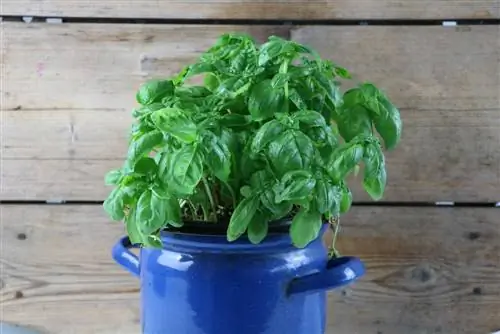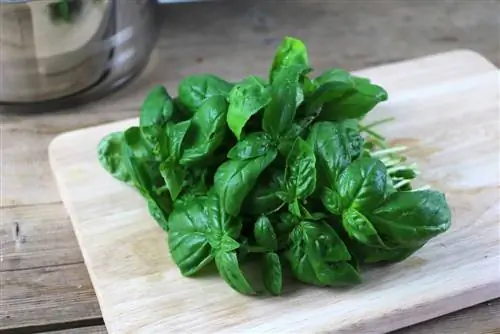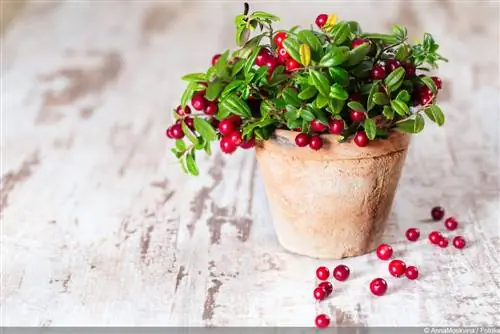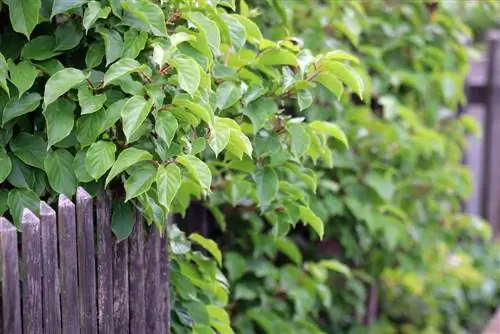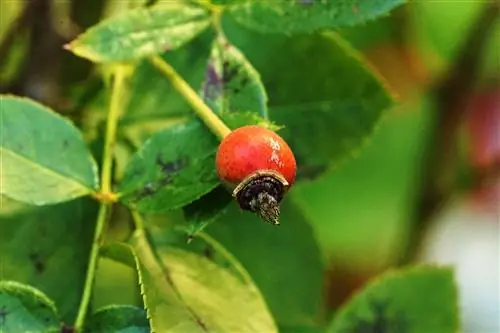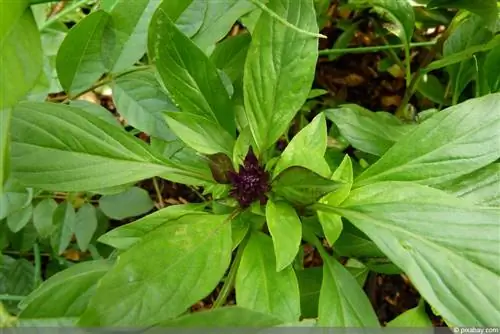- Author admin [email protected].
- Public 2023-12-17 03:39.
- Last modified 2025-06-01 06:48.
Growing basil is very rewarding and not difficult. This means you can plant several varieties at once and try out which ones are best suited to your own purposes. There are varieties that have a more peppery aroma, others taste like anise or cinnamon. There is sure to be a basil for every taste.
Basil profile
- Ocimum basilicum
- Spice plant with strong aroma
- Different cultural forms
- Origin can no longer be determined, it is suspected to be northwest India
- Differences in leaf color, size, aroma, growth type and requirements
- Actually a perennial plant, but we usually cultivate it as an annual
- Growth height 20 to 60 cm
- Flowers from June to September, small and white
- Small fruits
- Contains essential oil
- Used in cooking and also in medicine
Planting basil
Basil can of course be bought ready-made as a plant. You can find them at gardeners' shops, in hardware and plant stores and even in supermarkets or discounters. These specimens are usually not suitable for planting out. You continue to cultivate them in the container and then pot them into a slightly larger container. But basil has more to offer. There are an incredible number of different varieties that all want to be tested. Buying seeds is not a problem. Neither does the cultivation afterwards. Since the varieties can be very different in terms of both appearance and aroma, experimenting is really fun. There are a few things to consider, but neither cultivation nor care is difficult.
Sowing basil
Basil is easy to grow and quick too. The plants are ready to harvest in just 8 weeks. If you want to keep them in containers, you can sow them all year round. The best date for outdoor plants is from April. It is good to use potting soil because it is germ-free. To make it even more permeable, mix in 1/3 sand, moisten the soil and distribute seeds on top. They must not be covered with soil because they are light germinators. Press seeds lightly and cover container with foil or glass. It is placed warm and bright, but without sun. Temperatures above 20°C are favorable.
- Sowing for outdoor basil from April
- Mix potting soil with sand
- Light germinator
- About 10 seeds per container
- Moisten the substrate
- Cover the container with glass or foil
- Warm and bright place, without sun
- Water carefully, always keep slightly moist, not too wet
- Air regularly
- Remove the film if the seedling bumps into it
- Repot when a second pair of leaves has formed.
- Use more nutrient-rich soil
Site conditions
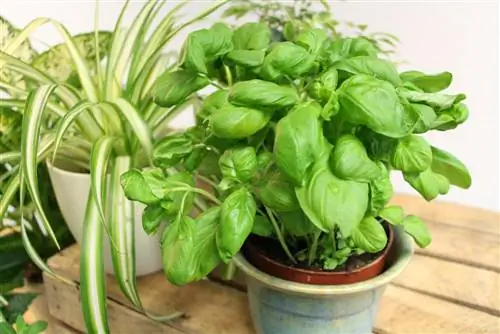
Basil is a plant that requires sun and warmth to thrive. Only a few varieties can cope with slightly lower temperatures. It is important to slowly acclimate the plants to the sun. Midday sun is not so favorable. A sheltered place is recommended. Rain is unfavorable for the plants, which is why they are best kept under cover. Basil should not be cultivated in a pot for long. Planting out is much better. Permeable, somewhat nutrient-rich soil is suitable as a substrate. Special herbal soil is not recommended, it is too low in nutrients.
- Sunny location, without midday sun
- Get used to the sun slowly
- Sheltered place
- Permeable, more nutrient-rich soil
- Temperatures above 20°C are ideal
- No temperatures below 10°C
Basil Care
Taking care of basil is not difficult. It is advisable to use scissors every now and then. In order to get a bushier plant and be able to harvest more leaves, the shoots should be trimmed in good time.
Watering and fertilizing
Basil needs regular water. The root ball should not dry out completely, but should not be too wet either. In particular, the plants are not affected by constant wetness. When watering, care should be taken not to get the leaves wet. It is best to pour directly onto the soil below. It's even better to submerge the entire pot so that the root ball can really soak up the water. Excess water is allowed to drain away. It is advisable not to use water that is too cold. There are differences when it comes to fertilizing. Basil in pots needs fertilizer every week, planted plants only every six weeks. Organic fertilizer is recommended since basil is consumed. A fairly high nitrogen content is important.
- Water regularly, but with feeling
- Don’t let the bale dry out
- No waterlogging
- It's cheap to dip bales
- Use tempered water
- Fertilize regularly
Propagation
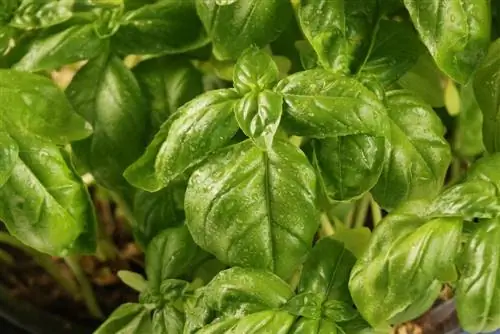
Basil can be propagated not only by sowing, but also by cuttings. This is also quite easy to do. What you need are a few shoots about 10 cm long from a he althy plant. Except for the top two pairs of leaves, all other leaves are removed. The cuttings are then simply placed in a glass of water. The first tender roots should have formed after just a week. After about 14 days, cuttings with strong roots can be planted. The delicate roots must not be damaged, so you have to be very careful with the plants. The soil must be well moistened. It should never dry out, but it shouldn't be too wet either. Both damage the roots. You put about 8 to 10 cuttings together in a pot.
- Cut 10 cm long shoots
- They must be very fresh
- Remove lower leaves
- Put the cutting in a glass of water
- After 14 days, plant the ones with the strongest roots
- 8 to 10 cuttings in one container
Overwintering basil
Most basil species die after flowering and have to be grown again and again. The perennial varieties can be overwintered, but not outdoors. You have to come into the house. Wintering is not without problems. The plants are often bothered by the low humidity and the rather weak light. However, it's worth a try. As soon as the temperatures fall below 10° in autumn, the basil plants need to be kept warm. They need a lot of light and temperatures between 15 and 20°C. The location directly above a heater is rather impractical. Watering is only moderate, but the plants should be sprayed with water more often. Alternatively, the plant can be placed in a container filled with water every 5 to 7 days so that the ball can soak up properly. The excess water must then be able to drain away. There is no fertilization in winter.
- Lots of light
- Temperatures between 15 and 20°C
- Water little
- Spraying plants
- Do not fertilize
Diseases and pests
Illnesses are often caused by care errors. Usually too much is watered. Mold and fungi are the result. The plants are weakened and become vulnerable to bacteria and viruses. This can also happen with dry skin. The plants also don’t like rain. The wetness can cause the same symptoms as too much watering.
- Leaf spot disease (fungal disease) - common during rainy periods, recognizable by spots on the leaf surface, usually slightly raised, rounded to irregularly shaped with small black fungal bodies. The spots appear sunken on the underside of the leaf. Stains can also flow into each other. Remove affected plant parts. An airy and protected location cannot prevent the disease, but it can prevent it.
- Downy mildew - yellowing or brown spots on the tops of the leaves, brown-gray fungal growth on the undersides, with severe infestation the leaves curl up and fall off. The fungus loves high humidity and cool temperatures. There are no pesticides. Cut back infected plants severely or remove them completely to prevent transmission and spread.
- Fusarium wilt - fungus that is encouraged by moist substrate and high temperatures. Soil fungus that penetrates the plants and clogs the pathways. Dead shoots or entire plants can be seen. Combat is not possible. Remove affected plants.
- Viral diseases often occur after cutting the stems. The interfaces are practically the entrance gates to the inside of the plant. Symptoms include curled leaves and poor general condition. The plant is slowly but surely dying.
- Alfalfa mosaic virus - Viral disease, widespread leaf yellowing, can be prevented by not growing basil near perennial stands of umbelliferous plants. No pesticides are permitted. The plants must be removed. Pests can also appear from time to time. Snails especially like basil and can decimate the population in one night.
- Caterpillars of the dock owl - red to grey-brown caterpillars and gray or brown tufts of hair all over the body, red dots on the back, up to 38 mm long, sitting on the leaves, must be collected
- Common meadow bugs - typical bug bodies, reddish brown to dark red or green to brownish. Collecting helps here.
- Snails - love basil. The normal check repellents help here.
Conclusion
Basil is delicious, he althy and easy to grow. There are so many varieties that it is often difficult to make a selection. The leaves of basil have many uses. It is used particularly frequently in Italian cuisine, not just with tomato mozzarella and pesto. The leaves are usually used fresh, but can also be dried, although they lose a lot of their aroma. Basil is also used as a macerate or distillate, often for herbal liqueurs. The cosmetics industry uses the essential oil for fragrance mixtures. Even the pharmaceutical industry likes basil and of course it has long been used in folk medicine. The anti-inflammatory effect makes it very popular. Basil is very versatile and should not be missing in any household.

